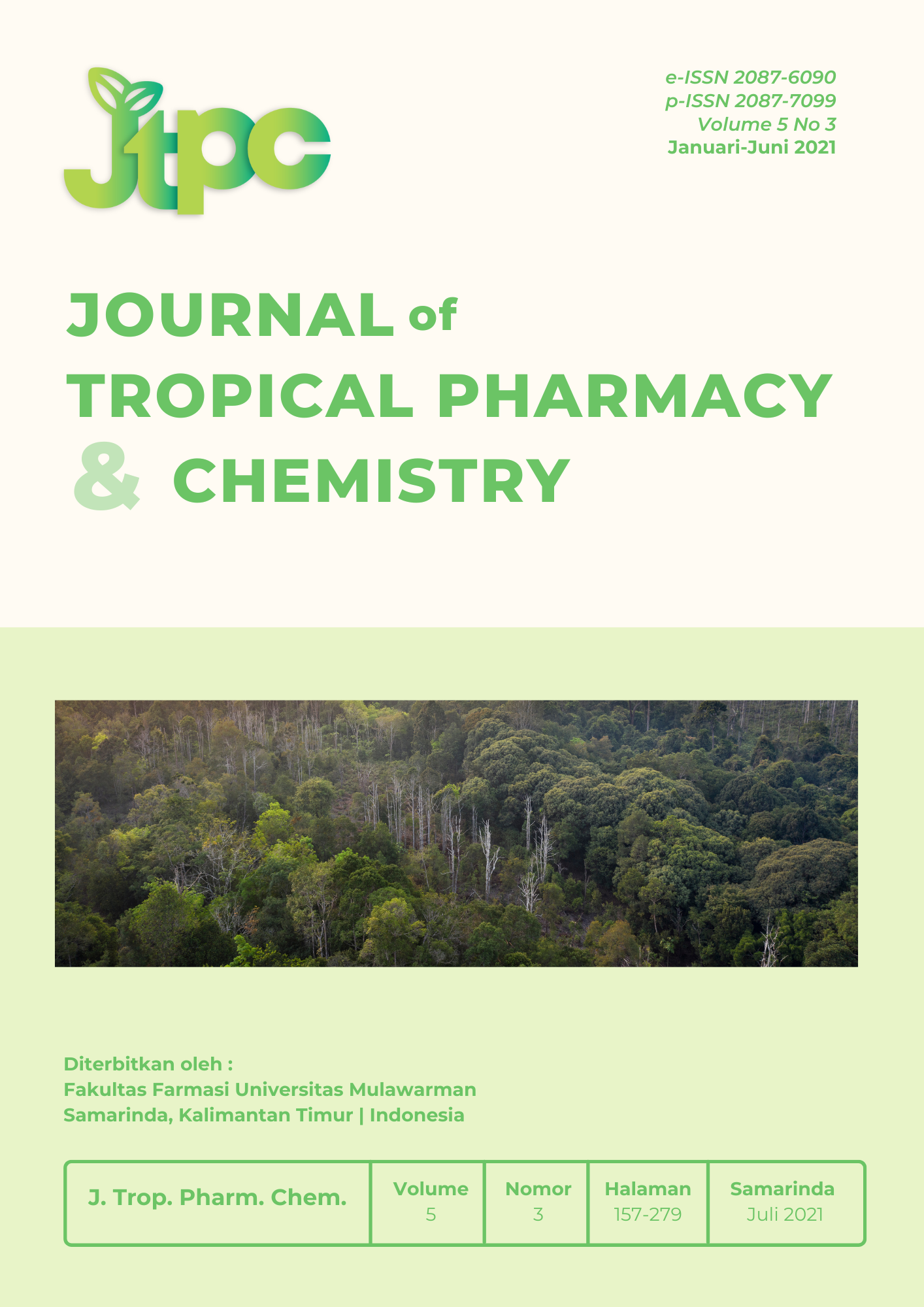Phytochemical Screening, Cytotoxicity and Antioxidant Activities of Leaves Extracts from Eucalyptus citriodora
DOI:
https://doi.org/10.30872/j.trop.pharm.chem.v5i3.198Keywords:
Eucalyptus, phytochemicals, brine shrimp, antioxidantAbstract
The genus Eucalyptus has been used in African traditional medicine for the treatment of cardiovascular diseases and diabetes. In this work, chloroform and methanol extracts from the leaves of Eucalyptus citriodora was investigated for their phytochemicals, cytotoxicity and antioxidant potentials. Phytochemical screening of the extracts showed the presence of alkaloid, flavonoid, phenols, reducing sugar and steroids in the methanol extract. IR absorptions of the extract supported the presence of these phytochemicals by revealing the bands 3335 cm-1 (O-H), 1613, 1480 cm-1 (C=C) and 1721 cm-1 (C=O). Evaluation of the cytotoxicity of the methanol extract using brine shrimp assay, suggested that, the extract was not toxic with LC50 value of 1.64 mg/mL. Antioxidant potentials of both chloroform and methanol extracts were determined using phenolic content quantification and 2,2-diphenyl-1-picrylhydrazyl (DPPH) radical scavenging. Methanol extract (37.32 ?g TAE/mg) had higher phenolic content than the chloroform extract (12.09 ?g TAE/mg). The radical scavenging potentials of the extracts recorded inhibitory activities of IC50 values of 892.7 ?g/mL (chloroform extract) and 8.3 ?g/mL (methanol extracts) relative to the positive control values of 31.1 ?g/mL (butylated hydroxytoluene) and 3.5 ?g/mL (ascorbic acid). These results showed that E. citriodora might contain promising antioxidant agents.
Downloads
References
[1] Sasikala, S. and Kalaimathi, J., 2014, Phytochemical analysis and antibacterial activity of Eucalyptus sp leaf extract against clinical pathogens. International Journal of Institutional Pharmacy and Life Sciences 4(6)
[2] Roja, G. and Rao, P.S., 2000, Anticancer compounds from tissue cultures of medicinal plant. J. Herbs, Spices Med. Plants 7:71-102.
[3] Nemudzivhadi, V. and Masoko, P., 2014, In VitroAssessment of Cytotoxicity, Antioxidant,and Anti-Inflammatory Activities ofRicinus communis(Euphorbiaceae) Leaf Extracts. Evidence-Based Complementary and Alternative Medicine. 2014:1-8.
[4] Nasr SM, Ghareeb MA, Mohamed MA, Elwan NM, Abdel-Aziz AWA, Abdel-Aziz MS., 2018, High-performance liquid chromatography- fingerprint analyses, In vitro cytotoxicity, antimicrobial and antioxidant activities of the extracts of two cestrum species growing in Egypt. Phcog Res. 10: 173-80.
[5] Khalighi-Sigaroodi, F., Ahvazi, M., Hadjiakhoondi, A., Taghizadeh, M., Yazdani, D., Khalighi-Sigaroodi, S. and Bidel, S., 2012, Cytotoxicity and Antioxidant Activity of 23 Plant Species of Leguminosae Family. Iranian Journal of Pharmaceutical Research. 11 (1): 295-302.
[6] Silva, J., Abebe, W., Sousa, S. M., Duarte, V. G., Machado, M. I. L., and Matos, F. J. A., 2003, Analgesic and anti-inflammatory effects of essential oils of Eucalyptus. Bioresource Tech., 89, 277-283
[7] Gomes-Carneiro, M. R., Felzenszwalb, I., Paumgartten, F. J., 1998, Mutagenicity testing (+/-)-camphor, 1,8-cineole, citral, citronellal, (-)-menthol and terpineol with the Salmonella/microsome assay. Mutat Res. 416(1-2):129-36.
[8] Muhammad, A. and Sirat, H. M., 2013, Antimicrobial, antityrosinase and brine shrimp lethality test of Bauhinia rufescens Lam (Fabaceae). Journal of Coastal Life Medicine; 1(2):123-128.
[9] Sofowora A., 1993, Medicinal Plants and Traditional Medicinal in Africa. 2nd Ed. Sunshine House, Ibadan, Nigeria: Spectrum Books Ltd. Screening Plants for Bioactive Agents; pp. 134–156.
[10] Cock, I. E. and Kalt, F. R., 2012, Gas chromatography-mass spectroscopy analysis of a Xanthorrhoea johnsonii leaf extract displaying apparent anaesthetic effects. Journal of Natural Pharmaceuticals. 3(2): 78-88.
[11] Kumar, S., Jyotirmayee, K. and Sarangi, M., 2013, Thin Layer Chromatography: A Tool of Biotechnology for Isolation of Bioactive Compounds from Medicinal Plants. International Journal of Pharmaceutical Sciences Review and Research, 18(1):126-132.
[12] Coates, J., 2000, Interpretation of Infrared Spectra: A Practical Approach. In: Meyers, R.A., Ed., Encyclopedia of Analytical Chemistry, John Wiley & Sons Ltd., Chichester, 10881-10882.
[13] Singleton V.L., Orthofer R. and Lamuela-Raventos R.M., 1999, Analysis of total phenols and other oxidation substrates and antioxidants by means of Folin-Ciocalteu reagent. Methods Enzymol. 1999; 299: 152-179.
[14] Sharma, Om P. and Bhat, Tej K., 2009, DPPH antioxidant assay. Journal of food chemistry 133: 1202-1205.
[15] Lachumy SJT, Sasidharan S, Sumathy V, Zuraini Z., 2010, Pharmacological activity, phytochemical analysis and toxicity of methanol extract of Etlingera elatior (torch ginger ) flowers. Asian Pac J Trop Med. 3(10): 769-774.
[16] Dapkevicius, A., Venskutonis, R., van Beek, T.A. and Linssen, J.P.H., 1998, Antioxidant activity of extracts obtained by different isolation procedures from some aromatic herbs grown in Lithuania. J. Sci. Food Agric., 77: 140-146.
[17] Koudoro, Y. A., Agbangnan Dossa, C. P., Yèhouénou, B. B., Tchobo, F. P., Alitonou, G. A., Avlessi, F., and Sohounhloué, D. C. K., 2014, Phytochemistry, antimicrobial and antiradical activities evaluation of essential oils, ethanolic and hydroethanolic extracts of the leaves of Eucalyptus citriodora hook from Benin. St. Cerc. St. CICBIA 15(1): 59-73.
[18] Wong, S. P., Leong, L. P., and Koh, J. H. W., 2006, Antioxidant activities of aqueous extracts of selected plants, Food Chemistry 99:775–783.
[19] Meyer B.N, Ferrigni, N.R., Putnam, J.E., Jacobsen, L.B., Nichols, D.E., McLaughlin, J.L., 1982, Brine shrimp: A convenient general bioassay for active plant constituents. Journal of Medicinal plant research 45: 31-34.




